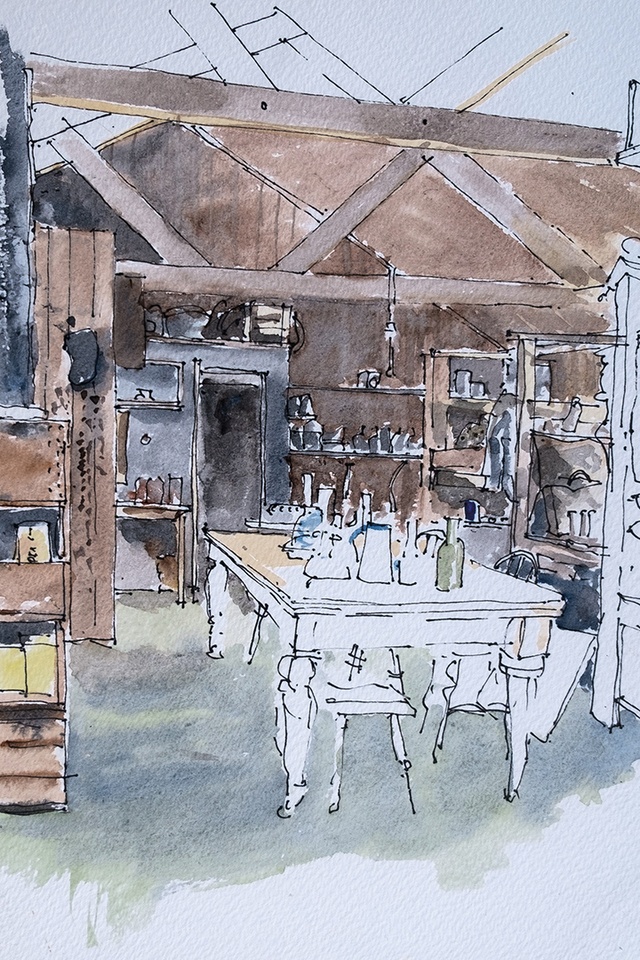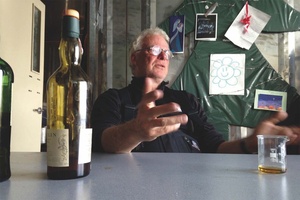Tables
It was a high noon moment, the sun hanging high, gazing down from a cyan sky on autumnal poplars arrayed like flaming Roman candles across the brown hills.

We were 20 farm gates south of Twizel, in a cul-de-sac valley opening to the lake, an arc of kennels, empty and silent, and a scruffy house with a shimmering cast-iron stove and a supine rabbit reclining in a bed of onions.
Sometime later, a Hilux wound its way down a farm track. We stood on the hard scrabble open ground; the driver’s door swung open and a large hand came towards me, its shadow sharp on the packed clay underfoot. Its owner was obscured by the late-afternoon sun peering over his shoulder: “you’d be the boys from Auckland then”. It wasn’t a question and we shuffled uneasily, our city smiles too quick in that slow, measured part of the island.
The rabbit and onion were an unusual mix, saved by the whiskey that drew our temporary host into a spirited address on the precision required when loading ammunition, the desirability of one or another model of Kalashnikov rifles, and the therapeutic value of meditation in preparation for culling the bunnies that infested the hillsides around us. Later, we sat around a small, square table, a low glow from the solar-powered light above casting long shadows from the shell cases laid out for our examination, not at all unlike a shadow diagram we might make for a consent application from a place that seemed, at that moment, impossibly far away to the north.
There were times when the intense focus on the mechanics of firepower induced a feeling of malice: a sense that perhaps the night had the possibility of some spectacular denouement such as Hollywood and Stephen King might conjure up. In the event the night passed without incident and when we rose the table was bare, the munitions and our host gone, to meditate or shoot we knew not.
I recalled the critical role another table had played a little north of those barren hills. I remember the uncertainty of our passage from the city, progress dependent on the vagaries of our Riley, nicknamed the “solid gold” in honour of the pounds Max poured into keeping its tappets in tune and the cooling system calm. The long, straight shingle roads of Mid Canterbury seemed endless as our family chugged south through clouds of dust, the planned breaks augmented by gatherings around the upraised hood amid the hiss of escaping steam and the drops of water escaping the radiator to fall onto the brown, wind-dried dust of the roadside.
The discomforts of tedium, heat and an overloaded car exaggerated the sense of distance to the destination and highlighted the shock of arrival and release into the discovery of an unfamiliar land. Smell and sound, as always, are the most poignant memory of those times, the dry dustiness and parched leather of the car’s interior a transitory spell between the sharp, salt-laden, booming seashore of home and the quiet, heavy smell of an inland macrocarpa hedge and the unfamiliar closeness of native bush.
The impenetrability of the bush at night drew a perimeter around a row of four houses who shared a driveway, picnics in the gorge and roadside cricket games in the long southern twilight. Later, to the sound of the adults dancing, shrieking and clinking glasses three houses over, we kids gathered to play Monopoly, learn the pleasure of our own company, and of being away from parental eyes. We gathered around a card table whose blue cotton cover was overlaid by the gameboard and a jumble of houses and hotels awaiting relocation to a completed subdivision. There were hoards of paper money stashed under the table’s cover, and deals conducted in flickering shadows cast by the moth-clad kerosene lantern hanging from the rafters above. That sphere of soft, hissing light enveloped those of us around the table, binding us into a tight holiday gang, which ranged across the backyards for three weeks; then we went our own ways as the school year loomed.
There are other tables too, more recently a gathering in the north where we brought tables from the neighbouring houses to make space for a growing studio, room for a celebratory dinner, the bowls, platters, glasses and bottles teetering in the candlelight over the conjunction of dissimilar tabletops. And so it was that we were grouped around a jumble of iPads, cups and pens in the studio the other day. There was a mix of media, some printouts from a computer model, cool and aloof in their clever rendering of dull vectors. There are ripped sheets of yellow trace too, smeared with thick black lines that bespeak impatience and moments of clarity and certainty that demand to be considered as soon as possible.
We are discussing a plan, that lovely moment when the walls and spaces are being nudged around: a time to savour. We have an inkling of an idea to guide us, an armature upon which to hang ideas, but there remains a tangle of contradictions to unravel; where is the view, where is the sun, what is the relationship with the kitchen? It’s the relationship between sitting, cooking and eating that’s being debated. To focus the discussion we have the table ‘on the table’, an empirical examination of the necessary criteria; how big is it, what is its orientation, is it near a wall, how high is the space, where are the windows?
I offered those moments from the south in support of the table as altar, a singular centring plane, the heart of the house around which life is lived. I thought it was self-evident that the exchange across the family table would only be weakened by distractions beyond that community. I have seen it up north, the close proximity of wide glazed doors opening to the ocean below stopping a conversation in mid-flight, the speaker’s attention drifting to the far horizon. Yet to my astonishment and no little chagrin, the importance of the to and fro across the table was not unequivocal and my companions were quite enthusiastic about an open window, birdsong and a decent outlook accompanying the breaking of bread.

I understand the aesthetics of a table and an open window but, frankly, I was disappointed by the privileging of style and the opportunity for distraction over something altogether more important, to wit, the community of the table and the symbolic importance of sharing food. I am tempted to launch a diatribe, referencing the prescriptive imperatives of those I railed against for so long: the extraordinary architectural aesthetics classes of Claude Megson or the strictures of Christopher Alexander’s A Pattern Language: Towns, Buildings, Construction. This may be the point at which I am unequivocally identified as a reactionary old bugger, though, of course, some of you have probably felt this for some time.
No, stuff it, this is important. The sharing of food and the exchange of ideas across the table is society writ small, personal and intimate. We know ourselves through the telling of stories, many across the table, and we have reached that table through companionship, the collective endeavour that has delivered bread and water, a table upon which to serve it and a room within which to do so. Let us not be distracted by the random chirpings of a tūī outside the window, an enchanting view or, for God’s sake, a damn cellphone.










